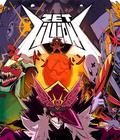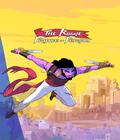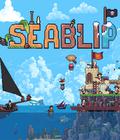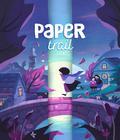If you're into puzzle games, you'll want to keep an eye on Paper Trail when it releases later this month. We had a chance to catch up with Henry Hoffman, the CEO at Newfangled Games, to talk about Paper Trail and the development process behind it.
Henry describes his role as the head of an indie developer as, "I do a little bit of everything, mechanic design, game design, a little bit of character, and a little bit of audio design as well."
This transcript has been lightly edited for clarity.
WorthPlaying: With Paper Trail, you're describing it as an origami adventure game. What exactly does that mean?
Henry Hoffman: So the idea is that it's kind of an adventure game. Imagine like old-school Zelda, where you've got lots of different screens that you can explore in kind of an open-world area, but each of those screens, instead of being like a level, is a piece of paper. The idea is that each of those pieces of paper has a front side and a back side. By folding that level over, you can merge those two sides and use it to solve puzzles and navigate spaces in interesting ways. You can create these Escher-esque illusions where you're rotating the background or folding over the background in order to create these new spaces to solve puzzles, so yeah, super exciting to work on.
WP: I noticed during the demo there was one little origami icon I couldn't access by folding the screen on an angle, but by moving around and refolding it in a different way, I got a little collectible. What are some of the more complex puzzles like? The early stages that we looked at are pretty straightforward, corners, sides. Do you do double fold, triple fold? Describe one of your later game puzzles.
Henry: Yeah, absolutely. It's funny that you mentioned double folds because that's something we explored pretty extensively, but because the game is a grid-based puzzle game, what happens when you start double folding is it starts breaking the grid. It was actually more confusing and frustrating for players with that mechanic, so that's one that we scrapped in the end.
Some of the later mechanics, we've got some interesting stuff. Essentially when we came up with the game mechanics, every single game mechanic in the game has to work with folding in an interesting way. We've got these teleporting doors, for example, where you've got an entry and an exit door, and only when they're both visible do the doors open so you can go through them. It allows you to essentially teleport from the front to the back of the paper and stuff, which is super cool.
A really late mechanic we added is mirrored folding. Every time you fold a paper, an adjacent paper folds in a mirrored way. Suddenly you've got to now navigate folding multiple pieces of paper at once.
We've got one of the favorite mechanics from players in the game, and it sounds pretty basic, is this power lines mechanic. You have these power lines that go through the level on the front and the back, and by folding them over and connecting them to a power source, you can power these power lines and open power doors and turn on machinery and stuff like that, which is cool.
WP: The game has a lot of hand-drawn visuals, and I understand that's somewhat of a family affair. What's it been like working with, or as CEO bossing around, your brother?
Henry: Yeah, absolutely. It's been surprisingly good. I think we both hold ourselves to quite high standards when it comes to artistic direction, so we don't really have disagreements because we both know we're trying to achieve the best game possible. So there's not really been any arguments per se.
I think maybe some friction arises when one of us thinks they're working harder than the other one or something like that, but generally, it's been pretty peaceful considering. It's actually been really nice. We've gotten on really well.
I think one of my brother's main complaints is that we only ever now talk about work, whereas before we would play video games, and have fun, and stuff like that. Now, whenever we're together, we're just talking about work all the time, so that's the only downside I can say with working with a close family member.
WP: Where did the idea come from? Are you and your brother huge origami fans? Did you see a book on it or watch someone doing it somewhere? What made you jump on saying, "This is the core mechanic of the game I want to do"?
Henry: It's interesting. I was in Mexico at the time, and Fred was in the UK, and we were just communicating over Facebook. We originally had the idea that you could create these foldable maps, so it was like a Metroidvania-style game where you don't necessarily see the level folding, but what you can do is, you can go to a map view and you can fold the map and that rearranges the game world essentially.
Very similar mechanic to Carto, I guess you could say, although Carto hadn't came out at the time. What we didn't like, is there wasn't any immediate feedback there, when you were folding the map. You couldn't really see how that was impacting the game world immediately, so what we did is, we zoomed in, and we were like, "OK, what about if we start folding the level?" and then the player can fold the level.
To begin with, it was a side-scrolling puzzle platformer, and we were like, "Oh we fold down the top, and there's a barrel or something, and then gravity means it falls out of the top into the level," and that was quite fun, but it wasn't as fun as when we started experimenting with top-down, and you could create these optical illusions by folding the walkable terrain from the back onto the front and stuff. It was mainly iteration and finding what made the folding most satisfying. It was generally top-down, puzzly gameplay.
WP: As a smaller indie developer, you're releasing on Xbox, PlayStation, Switch, PC, and mobile. What's it like dealing with all of that paperwork, all of these first parties, when you're a small indie developer versus a large game developer with a massive publishing team?
Henry: Absolutely it's tough because we're self-publishing as well, so that's a huge amount of work to take on. I think one of the things we underestimated is the amount of administrative overhead it is just to deal with these platforms, to get accounts, and to get dev kits, and stuff like that. With some of these partners, it took like eight months before we had a dev kit in the office, so it was just a lot of legwork.
I worked at a porting studio for a couple of years, so I had a good understanding of how to port games to these platforms. Actually, the porting process has been pretty smooth, pretty plain sailing. We had a great QA team who have helped us get through most of the certification challenges, but yeah, the real challenge was just the amount of emails I personally have to send in order to get shit from all these platforms, who have loads of other indies fighting for their attention. So yeah, the admin workload is crazy.
WP: Now that you're in the home stretch, what's next? Also, you mentioned that you went through cert, so for the players out there, can you explain what that means?
Henry: Yeah absolutely. So the certification process is basically, each platform has very specific requirements that it needs in order for your game to publish on that platform. It can be very minor things, like it could be the terminology, like the way that you say Nintendo or the way you refer to controllers, or the terminology in the game, all of that stuff, but it has to be checked really thoroughly.
If you're dealing with all these different platforms, they all have all these different requirements. You might fix one thing for PlayStation, for example, and then it breaks something for Nintendo. It's constantly this game of whack-a-mole essentially, and so that is a really time intensive process. I can understand why most indies don't sim ship on loads of different consoles at the same time, because it's a crazy amount of work. We kind of got there in the end.
In terms of what's next, we've started prototyping some new game ideas. We've got a little bit of government funding, which means we don't really have to worry about how many copies the game sells immediately. We can kind of roll into the next project. We want to take the core vision from this project, which is mechanic-driven game design, but do it in a way that's maybe 3D open world and has a bit broader appeal, I guess you could say. You kind of limit yourself by making just a regular puzzle game. By making something that is more appealing to traditional gamers in some ways, then you can kind of broaden your audience. That's kind of the goal for the studio longer term, to create games with broad appeal.
WP: Gaming audiences have definitely gotten broader over the last 20-30 years. Do you think Paper Trail could have existed 20 years ago?
Harry: I don't think it could have existed in a technological capacity. The current hardware can only just about run some of the runtime mesh deformation stuff that we're doing. But I don't think there would have been really much of an audience. I think that maybe there would have been around like the Braid, Fez, and Indie Game: The Movie era, when there were a lot of mechanic-driven games. I think it would have fit quite well in that time period. I think now we've got real broad gender appeal; there's a lot of cozy wholesome gamers who were giving us a lot of coverage. I think we fit really neatly into that cozy wholesome genre at the moment, so I think for us, it's the perfect time.
WP: So, folding paper takes a lot of horsepower? It looks fairly straightforward. How hard can it be to virtually fold a piece of paper?
Harry: The way that it works is, that you've got the front and the back of the paper that you're rendering separately. Then you've got multiple pieces of paper that are all visible at the same time. A normal game you would be rendering one screen, right? But in this game, you've got maybe six or seven pieces of paper with front and back sides that need to be rendered, so suddenly you've multiplied the computation, the rendering requirements, by like 20 or something.
So there's that initially, but then also the paper folding. The way that it works is, it is a three-dimensional mesh, where the front and the back are rendered onto that mesh, and then that mesh, as you drag it, it creates a runtime every frame. So every frame, that mesh is rebuilt. But it's not a normal mesh. In order to make it believable that it's paper, we had to create this rough edging to the paper, and in order to do that you have a thing called a nine-slice effect, where there's a mesh border going around the edge, and that is constantly being rebuilt, along with the folding, along with the shadow mesh.
There's so much mesh generation happening behind the scenes. We ended up writing our own triangulation algorithm because public triangulation algorithms were too slow for us to run on current hardware.
WP: As an indie dev, how did you hold yourselves back and keep yourself focused so you didn't try to throw in the kitchen sink? If you work for a larger company, there's always, "We can't do it because there's no budget." When it's your company and you can do whatever you want, how challenging is it to stay focused, rather than try to fit in one more thing?
Harry: Well, I'm not sure that we did a great job of that because there's been a lot of feature creep in this game! We kept pushing the release date back because, "Oh, we need to optimize for these platforms," or, "The game performance isn't great." So whilst that was happening we were like, "Oh, let's just put in one more feature, let's put one more feature!"
Actually, we added a load of game mechanics, and then we did a round of play testing, maybe two years into development, and some of the play testers absolutely hated some of the mechanics and the environments that we had done. We had gotten too distracted by, "Oh, this is a cool mind-bending mechanic", but actually for players, it was really disorienting and nauseating in some cases. So what we did is, we were like, "Oh shit, some of these game mechanics really are not fun, and players hate them." We went back, and we redesigned entire swaths of the game to better appeal to those audiences.
So I think we did add the kitchen sink, and then we were like, "Shit, players don't like some of these kitchen sink elements, so let's pare it back and redesign it." We were in a very fortunate position, where we partnered with Netflix games, which gave us a bit of a financial buffer and allowed us the space to make mistakes and to rebuild stuff that wasn't working.
WP: Is there anything we haven't talked about that you would like to add?
Henry: I want to say that on first impression, the game seems like it might be a complicated mind-bending puzzle game, but we've added in a really comprehensive hint system so you can look at the reverse of the paper at any time when you're playing a puzzle, which really helps with solving. Also we have a hint system which is just like a slider overlay. You do it, and then it shows the sequence of folds needed to solve the puzzle.
We're hoping that the game is going to be super accessible to all player types because there are those who like hardcore puzzles and then those that just kind of want to play through and want to experience the game. They can use our pretty well-defined hint system to help them out.
More articles about Paper Trail











 Paper Trail is a top-down puzzle adventure following Paige, a budding academic leaving home for the first time to pursue her studies in a foldable, paper world.
Paper Trail is a top-down puzzle adventure following Paige, a budding academic leaving home for the first time to pursue her studies in a foldable, paper world.








